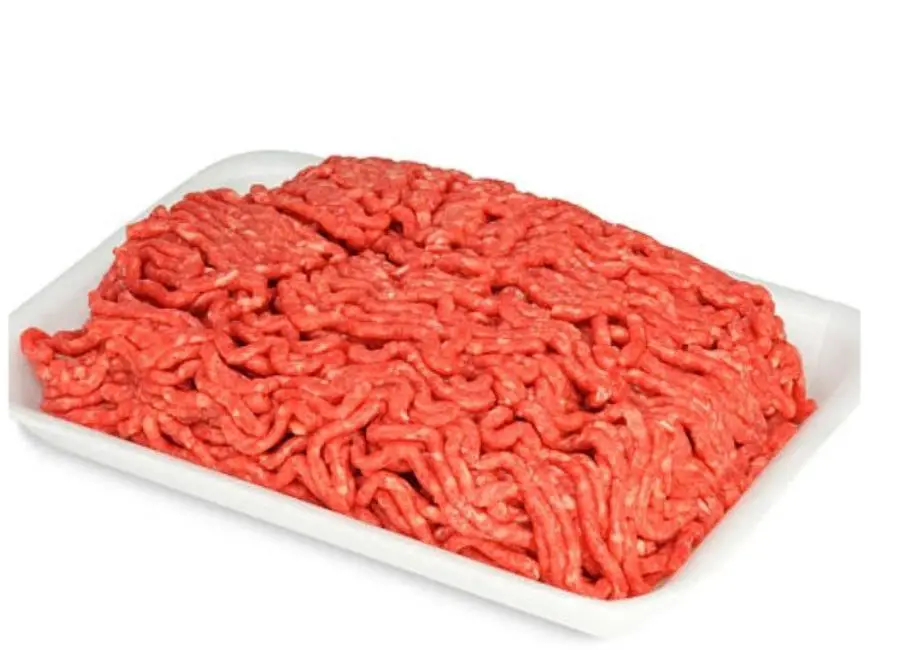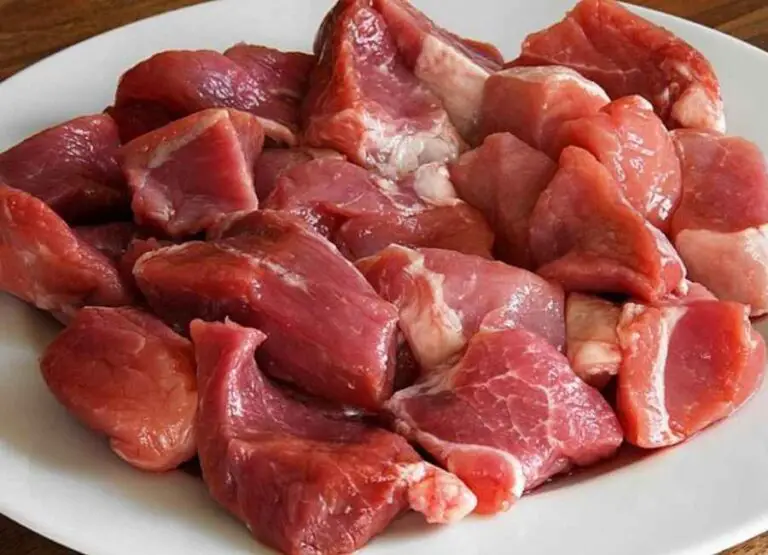How To Store Ground Beef [Useful Steps]
Let’s talk about how to store ground beef the right way…
If you’re a meat lover, you know the importance of having perfectly stored ground beef to create a delicious burger, meatballs, or even spaghetti.
Whether you buy your meat at the farmer’s market, the grocery store or order it online, storing it correctly is crucial to ensure its freshness and prevent the growth of bacteria that could cause food poisoning.
In this post, we’ll share with you some simple and effective tips on how to store ground beef and keep it juicy and flavorful for longer.
With these tips, you’ll be able to cook the perfect meat dish every time. So, let’s get started!
How To Store Ground Beef
Here’s the step-by-step process for how to store ground beef:
Step 1: Choose Fresh Ground Beef
To get the process started, start with fresh ground beef. Look for packages of ground beef that are chilly to the touch and properly sealed to avoid spillage.
Check to see if the meat is brilliant red and free of brown or gray discoloration. Check the expiration date as well to confirm its freshness.
Step 2: Refrigerate Immediately
It’s critical to refrigerate ground beef as soon as you get it home. Bacterial development happens quickly at room temperature, potentially jeopardizing the meat’s quality and safety.
Keep your ground beef in the coldest region of your refrigerator, ideally at 40 °F (4 °C) or lower.
Step 3: Choose the Right Packaging
Begin by inspecting the package your ground beef arrived in; if the original packaging is intact and unopened, you’re on the right track.
If the package has been tampered with, or if you bought ground beef from a local butcher, it’s time to repackage it yourself.
Choose airtight containers or freezer-safe bags for superior freezer burn prevention and to avoid cross-contamination with other food items.
Step 4: Portion the Ground Beef
Depending on your cooking needs, divide the ground beef into individual or family-sized pieces.
By doing so, you may simply thaw only the amount required for a specific meal without exposing the rest of the ground beef to temperature changes. Smaller quantities are also more convenient for defrosting.
Step 5: Use Proper Storage Containers
Transfer your ground beef into an airtight container or tightly wrap it in plastic wrap to keep it fresh and prevent cross-contamination.
A freezer-safe resealable bag is another option. Proper packaging keeps the meat from oxidizing and spoiling due to air exposure.
Step 6: Label and Date the Packaging
Grab a marker or labels and jot down the date of packaging before sealing your ground beef packages.
This simple process may appear little, but it is critical in maintaining the freshness and longevity of your ground beef. It guarantees that you use older pieces first to avoid confusion later on.
Step 7: Freezing Ground Beef
Freezing is your best friend when it comes to extending the shelf life of ground beef beyond a few days.
Make sure your packages are well-sealed to prevent air or moisture from seeping in.
Consider double-bagging or utilizing a vacuum sealer for increased security. Place the frozen boxed ground beef on a flat layer in the freezer.
This configuration saves space while allowing for faster and more even thawing when the time comes.
Step 8: Refrigerator Storage Option
If you intend to eat the ground beef within the following few days, store it in the refrigerator.
Place the ground beef packages in the coldest portion of your fridge, such as the bottom shelf or the meat drawer.
This maintains the temperature and avoids drippings from contaminating other meals.
Step 9: Thawing Frozen Ground Beef
When you’re ready to utilize your frozen ground beef, thawing it properly is critical to preserving both quality and safety.
Here’s how to go about it safely:
Transfer to the refrigerator: Remove the desired amount of frozen ground beef from the freezer and place it in the refrigerator. Allow it to progressively defrost to maintain a consistent and controlled temperature environment. Depending on the thickness of the meat, thawing in the refrigerator can take several hours or overnight.
Use the cold-water method: If you’re short on time, defrost frozen ground beef in a tight plastic bag in cold water. To maintain a safe temperature, change the water every 30 minutes. Warm or hot water, on the other hand, might promote bacterial development.
Use immediately: Cook your ground beef as soon as it has completely thawed. It’s not a good idea to refreeze thawed ground beef because it can ruin the texture and flavor.
Learn more about thawing ground beef on the counter.
Step 10: Proper Handling and Cooking
It’s critical to handle your thawed ground beef with caution. Remember to properly wash your hands before and after handling raw meat. To avoid cross-contamination, use separate cutting boards and utensils for raw meat.
To eradicate any potential microorganisms and ensure their safety for consumption, cook ground beef to an internal temperature of 160 °F (71 °C).
Learn more about why your frozen ground beef is brown.
Factors Affecting Ground Beef Storage
Ground beef storage is an important aspect of food safety, as improper storage can lead to bacterial growth and potential health risks.
Here are some factors that can affect ground beef storage:
- Temperature: Ground beef should be stored at a temperature below 40°F to keep bacterial levels low.
- Packaging: Ground beef should be stored in its original packaging, or wrapped tightly in plastic wrap or aluminum foil to prevent air from entering.
- Fat content: The fat content in ground beef can affect its storage time. Higher fat content can lead to a shorter shelf life.
- Exposure to air: Ground beef should be stored in airtight containers to prevent exposure to air, which can cause spoilage.
- Length of storage: Ground beef should be used or frozen within two days of purchase to ensure freshness.
- Cross-contamination: Ground beef should be stored separately from other foods to prevent cross-contamination.
- Humidity: High humidity can shorten the shelf life of ground beef, so it should be stored in a dry place.
- Method of storage: Ground beef can be stored in the refrigerator for short-term use or frozen for longer-term storage.
- Type of beef: Different types of beef have different shelf lives. For example, ground beef with a higher fat content may spoil faster than lean ground beef.
Learn more about identifying bad ground beef.
Understanding the Types of Ground Beef
There are several different types of ground beef that are commonly available in grocery stores.
Some of the main varieties include ground chuck, ground sirloin, ground round, and regular ground beef.
The fat content can vary among these types, with ground chuck typically being 80% lean and 20% fat, while ground sirloin is leaner at around 90% lean and 10% fat.
Regular ground beef may contain anywhere from 70% to 85% lean meat and can be a blend of several different cuts.
It’s important to consider the fat content when selecting ground beef, as this can affect the texture and flavor of the meat when cooked.
Learn more about dehydrating ground beef.
Best Practices for Storing Ground Beef
According to the FoodSafety.gov website, there are several best practices to follow when storing ground beef to ensure food safety.
Here are some of these best practices:
- Store ground beef at 40°F or below, either in the refrigerator or the freezer.
- Use ground beef within 1-2 days after purchase to ensure freshness.
- If you’re not going to use the ground beef within 1-2 days, freeze it until you’re ready to use it.
- Make sure to label and date the ground beef before placing it in the freezer.
- When freezing ground beef, use freezer bags or airtight containers to prevent freezer burn.
- Follow the USDA guidelines for freezing and thawing meat to prevent bacterial growth.
- When thawing frozen ground beef, do so in the refrigerator or in the microwave (if you’re going to use it immediately).
- Never leave thawed ground beef at room temperature for more than 2 hours.
- Cook ground beef to an internal temperature of 160°F to kill any harmful bacteria that may be present.
By following these best practices, you can help reduce the risk of foodborne illness from consuming ground beef.
Learn more about storing cooked ground beef.
Tips for Maximizing Ground Beef Storage
There are several tips for maximizing ground beef storage to ensure that it stays fresh and safe to eat.
Here are some suggestions:
- Store ground beef in the coldest part of your refrigerator, which is usually the back.
- Use ground beef within two days of purchase or freeze it.
- Keep ground beef wrapped tightly in plastic wrap or aluminum foil to prevent air and moisture from getting in.
- Freeze ground beef in portion-sized packages so that you can defrost only what you need.
- Label the ground beef packages with the date of purchase or freezing so that you can keep track of their freshness.
- Store ground beef at a temperature of 40 F (4.4 C) or below to keep bacterial levels low.
- Use ground beef within three to four months of freezing it to ensure its quality.
By following these tips, you can ensure that your ground beef stays fresh and safe to eat for as long as possible.
Related questions
How long can I keep ground beef in the refrigerator?
According to the USDA, raw ground beef can be stored in the refrigerator for 1–2 days, while cooked ground beef can be stored for up to 4 days.
Can I freeze ground beef?
Yes, you can freeze ground beef for up to 4 months. Be sure to wrap it tightly in plastic wrap and store it in an airtight container or freezer bag.
Should I season ground beef before I freeze it?
It is best to freeze ground beef in its raw state before seasoning it. Once it has thawed, you can then season it as desired.
How can I tell if ground beef is still good?
Use your senses. If it smells bad or has a slimy texture, it is likely spoiled and should be discarded. Additionally, if it has been in the refrigerator for longer than the recommended timeframe, it should be thrown away.
Can I thaw ground beef in the microwave?
Yes, you can thaw ground beef in the microwave using the defrost setting. However, it is important to cook the beef immediately after it has been thawed to avoid bacterial growth.
How should I store ground beef in the freezer?
To store ground beef in the freezer, wrap it tightly in plastic wrap and place it in an airtight container or freezer bag. Be sure to label it with the date you froze it and the type of meat it is. This will help you keep track of how long it has been frozen and ensure that you use it before it goes bad.
Conclusion
And there you have it, folks! Storing ground beef is simple and easy when you follow these practical tips.
Remember to always handle your food with care and keep it at the appropriate temperature to ensure it stays fresh and safe to eat.
With these tricks up your sleeve, you’ll never have to worry about wasting precious beef again.
So, next time you’re at the grocery store, load up on ground beef and feel confident that you know the best ways to store it! Happy cooking!





![How to Freeze Cooked Sausage [Step by Step Guide]](https://foodcreeks.com/wp-content/uploads/2023/05/Freeze-Cooked-Sausage-768x555.jpg)

